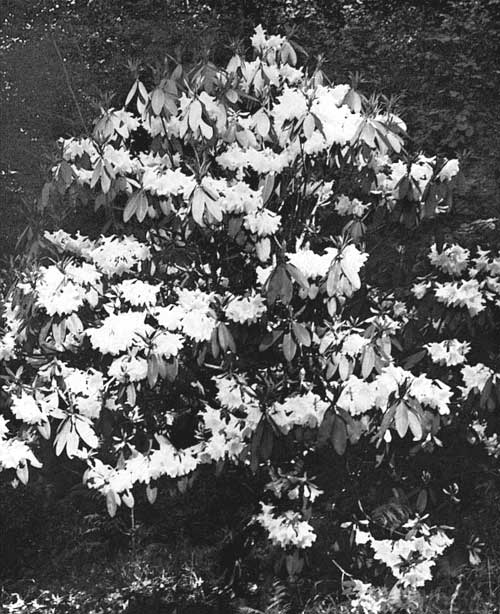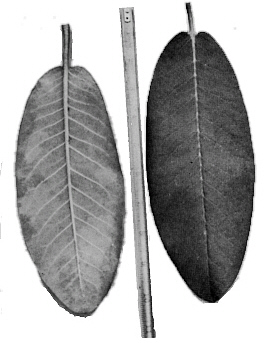R. auriculatum - A James Barto Contribution
By Carl H. Phetteplace, Eugene, Oregon

|
|
Fig. 46.
R. auriculatum
Phetteplace photo |
Rhododendron growers, especially those living in the Pacific Northwest, are increasingly impressed as we gain more knowledge and experience with the great contribution made to us by the late James Barto. During the twenties and the early 1930's, it is believed by those who are somewhat familiar with his work that he received seed, either directly or indirectly, from nearly every plant expedition that had been sent to the Far East. The fire which destroyed his home and most of his records about 1938, only a year before his untimely death, has left something to speculation and has made identification and appreciation of some of his material quite slow. So many of the fine things that were hauled away from his place in truck loads after his death have still to be accurately identified and other specimens have yet to come into flower. It has been said by some of our friends who are most familiar with Mr. Barto's work that by 1930 he was growing practically every rhododendron species then known to outdoor cultivation plus some of the tender, green house sorts.
One of these plants obtained from his place about fifteen years ago and now perhaps at least twenty years old is R. auriculatum shown in (Fig. 46). It presently is nearly twelve feet high and fourteen feet across. The trunk is about six inches through at the base. It is necessary to climb it like a fruit picker to remove the seed pods after flowering each year. The plant is growing in a cool, woodsy situation in the garden shaded from all except the very late afternoon sun. It receives abundant water all through the summer season and seems quite happy, still putting out several inches of new growth on each terminal each year. It first flowered when about ten or twelve years old. At that time, it was not an especially impressive specimen, although the leaves and flowers have always been interesting. I have known people to become discouraged at this point and relegate the plant to a little seen and poorly cared for portion of the garden or even destroy it altogether.
We have had at least three rather severe tests of cold since growing
R. auriculatum
. The one that would seem most likely to injure it was in November, 1955, when, after a mild fall, the temperature suddenly dropped to 12°F. Many varieties of rhododendrons here were still showing some new growth and the sap quite active. Such plants were hit very hard throughout the northwest. Since
R. auriculatum
does not start its abundant new growth until August and continues growing very actively well into October, it would seem that it would be most vulnerable to such an attack. However there was not the slightest damage to any part of the plant nor to next year's flower trusses. We have had other midwinter temperatures of 5°F. with no injury. This would suggest that
R. auriculatum
may well be one of our hardier rhododendrons.
Some growers have been discouraged in trying to grow
R. auriculatum
, because blooming in late summer as it does when the weather is at its warmest, causes the flowers to droop almost before there is time to enjoy them. Also the large, fragrant flowers attract the bees and humming-birds in great numbers and their incessant activity causes brown blotches on the corolla from the bruising, especially on warm days. I have found that the corolla does get brown spots, much like a gardenia, if it is handled much with the fingers or if overhead sprinkling is done on warm days. It does best grown in full shade or nearly so, watered abundantly until the buds start to expand and then no more overhead watering until the blooms fall. Marring of the flowers under these circumstances has not been noteworthy. It also seems that as the plant has become older with more abundant flowering, this damage from heat and insect is less and less noticeable. This year the trusses began to open on the first day of August, as is usual. The weather was then for the next week the warmest we had this summer (in the 90s). It was August 8th before the trusses sagged and there was very little brown spotting of flowers until the last. In the meantime, many people had seen and admired this plant and its striking display of white trusses.

|
|
Fig. 47. Leaves of
R. auriculatum
Phetteplace photo |
R. auriculatum
is a striking plant other than during the flowering season. Its size and general structure is, of course, impressive. The leaves are large and tend to stand out horizontally, which gives the plant a somewhat layered effect much of the year. The petiole on the leaves, especially the older ones, is red and this color distends up the midrib for a variable distance on different leaves. (Figure 47) is a picture of the two surfaces of the leaves. The leaf shown on the left is of the under surface and demonstrates the strong skeletal structure of the midrib and the primary veins. The other view shows the general shape with the auricled or ear-like base from which the rhododendron gets its name. These "ears" are actually a little more noticeable in looking at the plant than the picture suggests. Grossly the leaves have no indumentum, but under magnification, there are many slender stalked glands, especially about the petiole and the midrib.
Just before flowering, tremendous activity takes place. The flower buds rapidly become three inches or more in length and about an inch or more in thickness. They are then covered with quite red bud scales. At this time, all the terminals that are not to flower push out growth buds, which are about as long as the flower buds, but much more slender. These, too, are covered with red scales. These terminals continue pushing during the flowering season and soon after, exhibit the new leaves which have a bronze hue for a time. It is my impression that most of these terminals will eventually have next year's trusses. Near the end of August, then, growth starts to push out from each of the terminals that have borne trusses. This growth is three or four weeks later than that from the un-flowered terminals. It can thus be seen that the full winter dormant state would come quite late in the fall. In periods of exceptional cold, I have seen the leaves of this plant droop and curl snugly about the midrib, as is seen with most rhododendrons capable of enduring severe cold. As soon as the weather warms again, the leaves unfold and resume their more horizontal position.
The flowers occur in loose trusses of seven to twelve in number. They are funnel-shaped, three to four inches long and four inches across. They are seven lobed with slightly ruffled or crinkled edges. In the base of the corolla, there is a small blotch of reddish buff on the upper side and some greenish yellow on the lower side. On the exterior, the short calyx and the base of the corolla are biscuit color for a little way. Otherwise the flower is pure white. The outside of the corolla has many stalked glands. There are fourteen glabrous stamens with buff anthers. The style is glandular throughout.
A fine feature of
R. auriculatum
is its delicious fragrance. It is a sweet, slightly spicy fragrance, hard to describe, but very pleasing. It fills the air in the garden under favorable atmospheric conditions for many yards about. Now as I write this on August 24th, there are still enough straggling trusses in good shape to scent the air some distance away, although the ground beneath is strewn with the fallen blossoms.
Much thought has been given to
R. auriculatum
as a parent for hybridization, not only because of its fine, large, fragrant flowers, but especially because of the interesting possibility of extending the rhododendron season through its use. In 1956 R. H. S. Handbook, Part II, lists only twenty-one
R. auriculatum
hybrids and three of these are duplicates. Only seven in all are shown as having received an Award of Merit or a First Class Certificate. It has been my privilege to grow some half dozen or so of these hybrids. R. 'Aladdin' and R. 'Leonore' and
R. auriculatum
x R. 'Azor' all have had attractive pink flowers in July, but the plants so far have been very leggy and unattractive. The latter has always had the largest flowers that I have yet to see on an outdoor growing rhododendron, but a very loose truss. R. 'Chianti' did not prove at all vigorous in my garden, although a nice appearing small plant with a
thomsonii
-colored flower. After a few years, it finally died without apparent cause. Perhaps this was my fault. R. 'Lodauric' has been a very desirable, late, white fragrant flowered rhododendron, but was nearly killed by the 1955 frost, and although recovering finally, has not yet flowered again. This has been surprising, since neither of its parents were injured at all at this time though situated only a few yards away. R. 'Polar Bear' F.C.C. is a most striking plant with great leaves that I admire very much. It is six or seven years old and has not flowered, but I have great hopes for it. It has been quite hardy here. Perhaps I have not seen the best forms or clones of these hybrids. Possibly like
R. auriculatum
itself, these plants should have more age to become impressive. At this point, however, it is difficult to visualize how any of these hybrids can attain the blended beauty of plant structure, foliage, flower and growth characteristics that the parent possesses. Even so, they may be useful and worthwhile in our gardens. Few people feel that they would like to wait twenty years or more for
R. auriculatum
to reach the impressive state that it can become nor could many home gardens provide the room necessary for it. It is therefore not a rhododendron to be recommended for the average garden use. It is, however, incomparable for our test and exhibition gardens, arboretums, parks, estate and similar areas. In such places where shade and water can be provided, it should be planted in numbers. At maturity, there is no tree nor shrub of any other genus to my knowledge that is so impressive. It is to be hoped that there are those who will keel) propagating it so that it will never be lost to cultivation. Although some of us could never hope to see our new little plants mature to their full majesty, perhaps we could to this small extent emulate our great benefactor, Mr. Barto, and start something that would bring so much enjoyment and satisfaction to those who follow in the years to come.